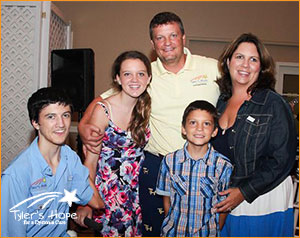The History of Tyler’s Hope for a Cure for
Dystonia Foundation

As a healthy and active 7-year-old boy, Tyler enjoyed playing basketball, soccer, tennis and golf. Just like most active 7-year-old boys, Tyler enjoys sports and playing outside.
In February of 2005 all of this changed. While practicing his basketball skills with his father, we noticed that Tyler could not bring his arm in without it shaking uncontrollably. We decided to have this examined and this was the beginning of a long and disheartening journey. Tyler was in and out of Shands Teaching Hospital in Gainesville, Florida and many other nationally renowned hospitals. Tyler was examined by many specialists that performed numerous painful tests and treatments that resulted in dead ends and misdiagnosis. This was extremely frustrating to everyone but none more than Tyler.
During one of Tyler’s inpatient stays at Shands, we were introduced to Dr. Michael Okun. This meeting resulted in his examining of Tyler and rendering a diagnosis of Primary Generalized Early-Onset Dystonia. This was confirmed with a blood test for the Dyt1 Dystonia gene. Though we were all relieved to have a “diagnosis”, we were also very distraught with what we learned about this devastating disorder.
Dystonia is a neurological movement disorder affecting the central nervous system characterized by involuntary and often painful spasms of the muscles. This disorder currently has no cure and progressively robs one of the ability to control voluntary movements and even the ability to walk.
The earlier that a child shows symptoms of Dystonia, the more significant those symptoms become. Our son, Tyler, is now very disabled. Although Tyler grows physically and mentally normally, he is twisted, cannot eat or speak without extreme difficulty, cannot walk, read a book, or play with other kids like he used to. Tyler is remarkably good-natured and continues to have a positive attitude about his dystonia. A few years after Tyler’s diagnosis our daughter Samantha started showing symptoms and was diagnosed with generalized dystonia. Since Tyler and Samantha have the genetic form, there is a 50/50 chance that our youngest child will carry this gene and a 30% chance that he will become symptomatic of it.
It is our goal and the mission of Tyler’s Hope Foundation to raise awareness of this horrible disorder so no other child has to experience what Tyler went through to be diagnosed. Tyler’s Hope Foundation was established to advance research for a cure, discover effective treatments and to promote awareness and education of this devastating disorder. Please see “where the money goes” on the Tyler’s Hope website.
In February of 2005 all of this changed. While practicing his basketball skills with his father, we noticed that Tyler could not bring his arm in without it shaking uncontrollably. We decided to have this examined and this was the beginning of a long and disheartening journey. Tyler was in and out of Shands Teaching Hospital in Gainesville, Florida and many other nationally renowned hospitals. Tyler was examined by many specialists that performed numerous painful tests and treatments that resulted in dead ends and misdiagnosis. This was extremely frustrating to everyone but none more than Tyler.
During one of Tyler’s inpatient stays at Shands, we were introduced to Dr. Michael Okun. This meeting resulted in his examining of Tyler and rendering a diagnosis of Primary Generalized Early-Onset Dystonia. This was confirmed with a blood test for the Dyt1 Dystonia gene. Though we were all relieved to have a “diagnosis”, we were also very distraught with what we learned about this devastating disorder.
Dystonia is a neurological movement disorder affecting the central nervous system characterized by involuntary and often painful spasms of the muscles. This disorder currently has no cure and progressively robs one of the ability to control voluntary movements and even the ability to walk.
The earlier that a child shows symptoms of Dystonia, the more significant those symptoms become. Our son, Tyler, is now very disabled. Although Tyler grows physically and mentally normally, he is twisted, cannot eat or speak without extreme difficulty, cannot walk, read a book, or play with other kids like he used to. Tyler is remarkably good-natured and continues to have a positive attitude about his dystonia. A few years after Tyler’s diagnosis our daughter Samantha started showing symptoms and was diagnosed with generalized dystonia. Since Tyler and Samantha have the genetic form, there is a 50/50 chance that our youngest child will carry this gene and a 30% chance that he will become symptomatic of it.
It is our goal and the mission of Tyler’s Hope Foundation to raise awareness of this horrible disorder so no other child has to experience what Tyler went through to be diagnosed. Tyler’s Hope Foundation was established to advance research for a cure, discover effective treatments and to promote awareness and education of this devastating disorder. Please see “where the money goes” on the Tyler’s Hope website.
